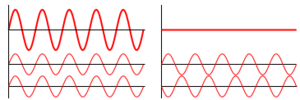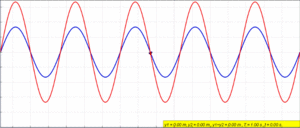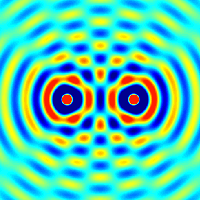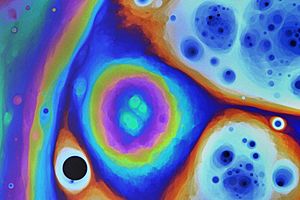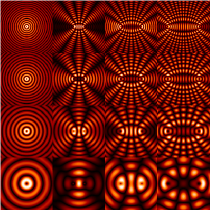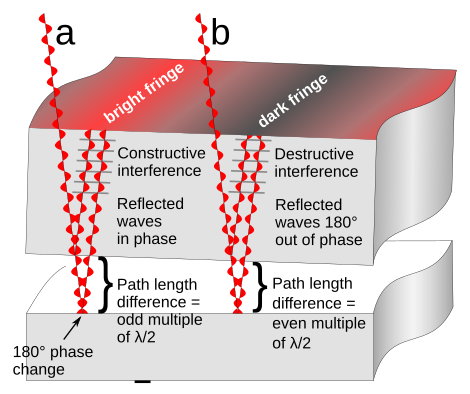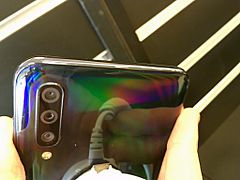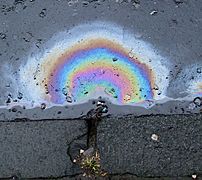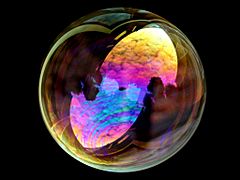Wave interference facts for kids
In physics, interference happens when two or more waves meet and combine. This combination can make the waves stronger or weaker. It depends on how the waves line up with each other.
If the waves line up perfectly, they add up to create a bigger wave. This is called constructive interference. If they are out of sync, they can cancel each other out. This makes the wave smaller or even disappear. This is called destructive interference.
You can see interference with many types of waves. This includes light waves, radio waves, sound waves, and even water waves.
What Does "Interference" Mean?
The word interference comes from Latin words. Inter means "between," and fere means "hit or strike." A scientist named Thomas Young first used this word in 1801.
How Waves Interfere
Imagine dropping two pebbles into a still pond. Each pebble makes ripples, which are circular waves. When these waves spread out and meet, they combine.
The idea that waves combine is called the superposition principle. It means that when waves meet at the same spot, their effects add up.
- If a high point (crest) of one wave meets a high point of another wave, they add up. This makes an even higher wave. This is constructive interference.
- If a high point (crest) of one wave meets a low point (trough) of another wave, they can cancel each other out. This makes the wave smaller or flat. This is destructive interference.
Even when waves cancel out, the energy doesn't just disappear. It's stored in the material the wave is traveling through. For example, in water, the energy is still there, ready to become a wave again.
Constructive interference happens when waves are perfectly in sync. Destructive interference happens when they are completely out of sync. If they are somewhere in between, the combined wave will be somewhere between its biggest and smallest possible size.
Light waves also interfere. We can't see the light waves themselves directly. But we can see the results of their interference. Famous examples include the double-slit experiment and the colors you see in anti-glare coatings on glasses.
Interference from Two Point Sources
Imagine two small light sources, like tiny light bulbs. Each source sends out waves in all directions, like ripples from a stone in water. When these waves overlap, they create an interference pattern.
This pattern shows where the waves are in sync (bright spots) and where they cancel out (dark spots). The pattern changes depending on the light's wavelength (its color) and how far apart the two light sources are.
If you look at the pattern from far away, it will look like straight lines. This is because the waves appear almost flat from a distance.
Many Waves Interfering
Interference can also happen when many waves combine. This is used in things like 3-phase power and diffraction gratings. In these cases, waves are carefully spaced so they add up or cancel out in specific ways.
For example, a Fabry–Pérot interferometer uses many reflections to create interference. A diffraction grating creates bright spots by making light waves from many tiny slits interfere.
Optical Wave Interference
Our eyes can't see the super fast changes in light waves. Instead, we see the brightness, or intensity, of the light. The brightness of an interference pattern depends on how the waves combine.
- If two light beams of equal brightness interfere, the brightest spots can be four times brighter than a single beam.
- The darkest spots can be completely dark, with zero brightness.
For light waves to interfere, they usually need to have the same polarization. Think of polarization as the direction the wave vibrates. If they vibrate in different directions, they can't fully cancel or add up.
Scientists like Paul Dirac and Richard Feynman have explained light interference using quantum mechanics. Dirac famously said, "every photon interferes with itself." This means even a single particle of light (a photon) can show wave-like behavior and interfere.
What Light Sources Are Needed?
To see clear interference patterns, the light waves need to be "coherent." This means they need to have a steady relationship between their phases.
Old light sources, like regular light bulbs, send out light waves that are all mixed up. They have different frequencies and come from different places. So, it's hard to see clear interference patterns with them.
However, special lamps like sodium-vapor lamps produce light with a very narrow range of frequencies. If this light is carefully filtered, it can be used to create interference patterns. Many early experiments used these types of sources.
Lasers are much better for interference experiments. They produce light that is very "clean" and coherent. This makes it much easier to see interference patterns. Sometimes, lasers are so good that even accidental reflections can create unwanted interference patterns!
You can even see interference with white light. White light is made of all colors (wavelengths). When white light interferes, you see a few colored fringes. This is because each color creates its own pattern, and they only line up perfectly in the center. This "white light fringe" is useful because it helps scientists find the exact point where the two light paths are equal.
How Light Is Set Up for Interference
To make light waves interfere, you need to split a light beam into two parts. Then you bring these two parts back together.
- Amplitude-division systems use a beam splitter. This is a special mirror that splits the light into two beams. The Michelson interferometer is an example of this.
- Wavefront-division systems split the light by sending it through different parts of a wave. Young's double slit experiment is a famous example. Here, light passes through two tiny slits, and the waves from each slit interfere.
You can see interference in everyday life. The beautiful colors in a soap bubble are due to interference. Light reflects off the front and back surfaces of the thin soap film. Depending on the film's thickness, different colors interfere constructively, making them appear bright.
- Colors caused by thin-film interference
Quantum Interference
Quantum interference is similar to light interference. It shows that tiny particles, like electrons or atoms, can also act like waves.
The most famous example is the double-slit experiment. In this experiment, tiny particles are shot at a barrier with two slits. Even if you send them one by one, they create an interference pattern on the other side. This shows that each particle acts like a wave and goes through both slits at once. This is a key idea in quantum mechanics.
How Interference Is Used
Beats
In acoustics, a beat is an interference pattern between two sounds. These sounds have slightly different pitches. What you hear is a regular change in how loud the sound is.
You can easily hear beats when tuning musical instruments. If two notes are almost the same pitch but not quite, you'll hear a "wobbling" sound. This wobbling is the beat. As the notes get closer to being perfectly in tune, the wobbling slows down. When they are perfectly in tune, the wobbling stops.
Optical Interferometry
Interferometry, using light interference, has been very important in physics. It's also used in many ways to measure things in science and engineering.
Thomas Young's double-slit experiment in 1803 was a big deal. It showed clear interference patterns with light. This helped prove that light acts like a wave. Later, Richard Feynman said that this one experiment holds the key to understanding all of quantum mechanics.
The Michelson–Morley experiment used interferometry. Its results helped show that there was no "luminiferous aether," a substance people thought light traveled through. This experiment supported special relativity.
Interferometry is also used to define and check length standards. For a long time, the definition of a meter was based on the wavelength of light from a krypton atom. Even today, interferometry is key for very accurate length measurements. It's used to check tools and parts in factories.
Radio Interferometry
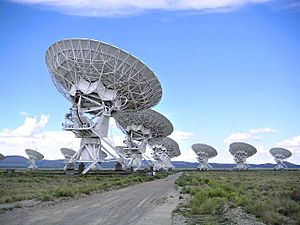
In 1946, scientists developed astronomical interferometry. This technique uses many radio telescopes spread far apart. They collect radio waves from space. By combining the signals from all these telescopes, they use interference to create a much clearer image. It's like having one giant telescope as big as the distance between the farthest two telescopes. This helps astronomers see very distant and faint objects in space.
Acoustic Interferometry
An acoustic interferometer is a tool that measures properties of sound waves in a gas or liquid. It can measure things like how fast sound travels, its wavelength, or how much it's absorbed. It works by sending out ultrasonic waves and then measuring how they interfere when they reflect back.
See also
 In Spanish: Interferencia para niños
In Spanish: Interferencia para niños
- Active noise control
- Beat (acoustics)
- Coherence (physics)
- Diffraction
- Interferometer
- Newton's rings
- Thin-film interference


